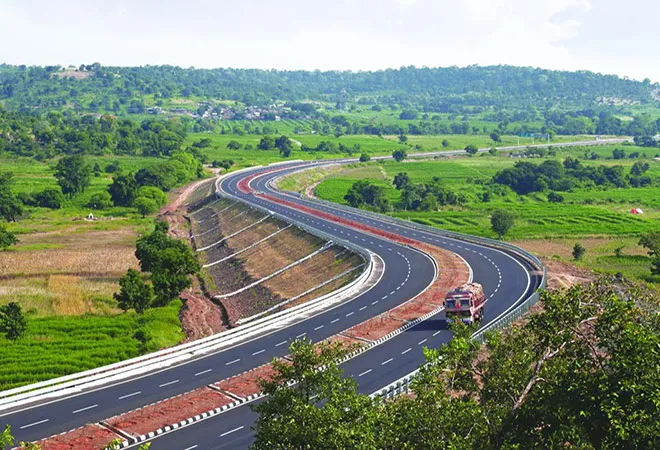
On the sidelines of the recently concluded 12
th Mekong Ganga Cooperation (MGC) meeting in Bangkok on 16 July,
Indian External Affairs Minister Dr. S. Jaishankar met with his Myanmar counterpart U Than Swe to discuss regional connectivity initiatives, with particular emphasis on expediting the India-Myanmar-Thailand Trilateral Highway (IMT-TH) project. He emphasised the importance of peace and stability in border areas, expressed concerns about trafficking, reiterated India's support for Myanmar's democratic transition, proposed people-centric initiatives to address pressing challenges, and aimed to closely coordinate its policy with ASEAN regarding Myanmar.
The IMT-TH presents a significant opportunity for enhanced connectivity and regional integration. It aims to connect India's Northeast region with Thailand via Myanmar, facilitating trade and commerce, health, education, and tourism between the three nations while providing a more efficient and cost-effective transportation route. India has proposed extending the road network to include Cambodia, Laos, and Vietnam, further expanding its reach and potential impact. Bangladesh is also interested in joining the initiative for enhancing trade links and tourism.
It aims to connect India's Northeast region with Thailand via Myanmar, facilitating trade and commerce, health, education, and tourism between the three nations while providing a more efficient and cost-effective transportation route.
Since its conception in 2002, the Trilateral Highway project has faced various delays and challenges, including political instability in Myanmar and financial issues. Nonetheless, recent years have seen progress, with several stretches of the highway being completed or nearing completion. The project aims to establish an essential strategic route, but earlier targets for its operationalisation have been delayed. Initially, the government sought to make the highway operational by 2015 and then extended the timeline till 2019. Now, the
new deadline is set for 2027. It is, thus, crucial to closely assess the current situation on the ground to gauge the progress of this delayed project.
The IMT-TH project follows a proposed plan that starts from Bangkok and passes through cities like Sukhothai and Mae Sot in Thailand, and Yangon, Mandalay, Kalewa, and Tamu in Myanmar before reaching India. In India, it is likely to pass through Moreh, Kohima, Guwahati, Srirampur, Siliguri, and Kolkata, ning over 2,800 km. The longest stretch of the highway will be in India, while the most minor road section will be in Thailand.
Thailand's Vice Minister of Foreign Affairs, Vijavat Isarabhakdi, stated in a recent interview that most of the project's work in Thailand is over. The Indian counterpart also mentioned that around
70 percent of the work is complete. Upon being approached, Aung Naing Oo, Myanmar's Trade Minister, revealed that most of the highway was constructed, ning
1,512 km. The contractors will complete the remaining sections within three years.
The longest stretch of the highway will be in India, while the most minor road section will be in Thailand.
Persisting bottlenecks
The IMT-TH project encompasses a vital road network in Myanmar, which, despite having witnessed notable development in recent times, still needs progress at numerous stretches. Several sections of the original IMT-TH alignments have been completed or upgraded, including the crucial bypass road connecting Myawaddy and Kawkareik in Thailand and the second friendship bridge linking Myawaddy and Mae Sot. Additionally, ongoing efforts involve the improvement and repair of roads between Kalewa (India) and Monywa (Myanmar), the construction of a new Bago bridge supported by Japan, and the development of an arterial road connecting Bago and Kyaikto in Myanmar, facilitated by the Asian Development Bank (ADB). However, urgent attention is required to
replace 69 bridges along the Tamu-Kyigone-Kalewa road. Work on this stretch has been delayed since 2015 due to the termination of the contractor’s agreement. Recently, reports suggest that work on the first bridge between Moreh (in Manipur) and Tamu (in Myanmar) is expected to restart soon. However, a proper timeline is needed.
Construction is underway on the difficult Yar Gyi road section, a significant part of the Trilateral Highway. This particular stretch is characterised by steep gradients and sharp curves, posing considerable challenges to the construction process. Currently, only
about 25 percent of the road is complete. The Trade Minister of Myanmar has indicated that converting a 121.8-km portion of the road, specifically between Kalewa and Yar Gyi, into a four-lane motorway will require more time than anticipated. Consequently, the construction team may need to extend or postpone the initial deadline for completion.
The Trade Minister of Myanmar has indicated that converting a 121.8-km portion of the road, specifically between Kalewa and Yar Gyi, into a four-lane motorway will require more time than anticipated.
Additionally, significant security issues persist in Myanmar. The Chin State and Sagaing Region, where the majority of the work is ongoing, are engulfed in conflict between the Junta and the ethnic armed groups. If the conditions do not subside, the resumption of work by contractors seems improbable.
Another aspect that needs immediate attention is formulating and implementing the IMT Trilateral Motor Vehicle Agreement (IMT-TMVA). While the Indian government conducted the IMT-TH Friendship Car Rally in 2016 to sensitise stakeholders to the potential benefits of a motor vehicles agreement (MVA) between the three countries, not much has occurred. There are several reasons for this; one of the biggest challenges to implementing the IMT-TMVA is the need for more infrastructure, particularly in Myanmar. The
country has limited road networks and poor connectivity, which makes it difficult for vehicles to move smoothly between India, Myanmar, and Thailand. Bureaucratic hurdles continue to remain a significant bottleneck, where obtaining permits and clearances remains challenging due to differences in the rules and procedures of vehicle movement in each nation making the situation time-consuming and cumbersome. This will be particularly challenging for small- and medium-sized enterprises (SMEs), which may need more resources to navigate complex regulatory frameworks.
Additionally, the security situation in Myanmar is also a significant concern for the implementation of the IMT-TMVA. The country has faced political instability and conflict in recent years, which has affected road transport safety. There have been reports of attacks on vehicles and disruption of transport routes, which can be a significant risk for businesses and travellers. This has led to concerns about the safety of drivers and passengers, which may impact the viability of any agreement.
Adequate financing and resource allocation will play a vital role in overcoming these challenges and realising the full potential of this transformative regional initiative.
Key factors for consideration
Addressing infrastructure limitations, bureaucratic hurdles, and security concerns will ensure smooth cross-border transportation and maximise the benefits of the Trilateral Highway and the IMT-TMVA. Adequate financing and resource allocation will play a vital role in overcoming these challenges and realising the full potential of this transformative regional initiative.
India's commitment to supporting Myanmar's democratic transition process and its emphasis on peace and stability are integral to the region's progress and prosperity. Strengthening policy coordination with ASEAN regarding Myanmar will contribute to a more holistic approach to regional issues and ensure a stable environment for connectivity projects to thrive.
Overall, the successful completion of the India-Myanmar-Thailand Trilateral Highway hopes to not only bolster economic growth but also pave the way for more robust regional integration, cultural exchange, and cooperation among the participating nations, ultimately contributing to peace, stability, and prosperity in the Mekong-Ganga region.
Sreeparna Banerjee is a Junior Fellow with the Strategic Studies Programme at the Observer Research Foundation.
The views expressed above belong to the author(s). ORF research and analyses now available on Telegram! Click here to access our curated content — blogs, longforms and interviews.



 On the sidelines of the recently concluded 12th Mekong Ganga Cooperation (MGC) meeting in Bangkok on 16 July,
On the sidelines of the recently concluded 12th Mekong Ganga Cooperation (MGC) meeting in Bangkok on 16 July,  PREV
PREV


